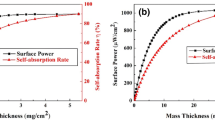Abstract
Among the various micro-powers being investigated, betavoltaic batteries are very attractive for numerous applications because of their advantages of high energy density, long life, strong anti-interference, and so on. Based on the basic principle of the betavoltaic effect, the current paper adopted the Monte Carlo N-Particle code to simulate the transport processes of β particles in semiconductor materials and to establish the calculation formulas for nuclear radiation-generated current, open circuit voltage, and so on. By discussing the effect of minority carrier diffusion length, doping concentration, and junction depth on the property of batteries, the present work concluded that the best parameters for batteries are the use of silicon and the radioisotope Ni-63, i.e., Ni-63 with a mass thickness of 1 mg/cm2, N a =1×1019 cm−3, N d =3.16×1016 cm−3, junction area of 1 cm2, junction depth of 0.3 μm, and so on. Under these parameters the short-circuit current, open circuit voltage, output power, and conversion efficiency are 573.3 nA, 0.253 V, 99.85 nW, and 4.94%, respectively. Such parameters are valuable for micro-power fields, such as micro-electromechanical systems and pacemakers, among others.
Similar content being viewed by others
References
Wang T S, Zhang B G. The radio-voltaic effect applied to radioisotopic decay energy power generation. Nucl Tech, 1995, 18(012): 740–743
Zou Y, Huang N K. Basic principles and developments of the radioisotope powered voltaic batteries. Nucl Tech, 2006, 29(6): 432–437
Sun L, Yuan W Z, Qiao D Y. Research on a novel radioisotrope micro battery based on MEMS technology. J Funct Mater Devic, 2006, 12(005): 434–438
Guo H, Yang H, Zhang Y. Betavoltaic micro batteries using porous silicon. Proceedings of the 20th IEEE Micro Electro Mechanical Systems, Japan Kobe, 2007. 867–870
Deus S. Tritium-powered betavoltaic cells based on amorphous silicon. Conference Record of the Twenty-Eighth IEEE Photovoltaic Specialists Conference, 2000. 1246–1249
Qin C. Modeling and performance analysis of MEMS isotope microbattery. Xi’an: Northwestern Polytechnical University, 2007. 22–29
Guo H, Lal A. Nanopower betavoltaic microbatteries. Proceedings of 12th International Conference on Transducers, Solid-State Sensors, Actuators and Microsystems, 2003. 36–39
Xu S Y. Monte Carlo Methods in Experimental Nuclear Physics Applications. Beijing: Atomic Energy Press, 2006. 262–270
Briesmeister J F. MCNP-A general monte carlo n-particle transport code, Version 4C. LA-12625, 1993
Honsberg C. GaN betavoltaic energy converters. Conference Record of the Thirty-First IEEE Photovoltaic Specialists Conference, 2005. 102–105
Mohamadian S M, Feghhi S A H, Afarideh H. Analyze and simulation of a typical mems rpg using mcnp code. Icone16: Proceeding of the 16th International Conference on Nuclear Engineering, 2008, 1: 883–886
Anderson B L. Fundamentals of Semiconductor Devices. Boston: McGraw-Hill Higher Education, 2005. 83–120
Author information
Authors and Affiliations
Corresponding author
Rights and permissions
About this article
Cite this article
Tang, X., Ding, D., Liu, Y. et al. Optimization design and analysis of Si-63Ni betavoltaic battery. Sci. China Technol. Sci. 55, 990–996 (2012). https://doi.org/10.1007/s11431-012-4752-6
Received:
Accepted:
Published:
Issue Date:
DOI: https://doi.org/10.1007/s11431-012-4752-6




